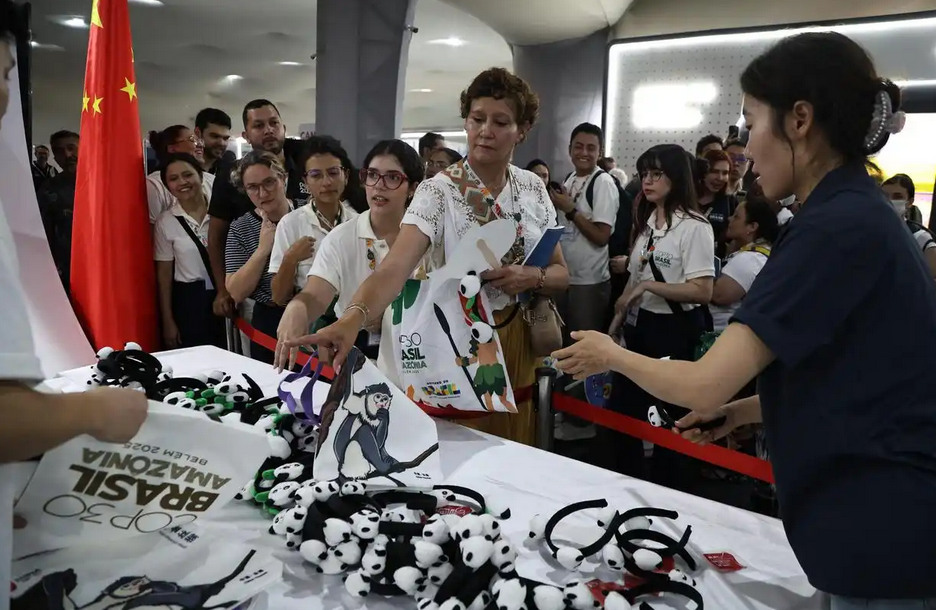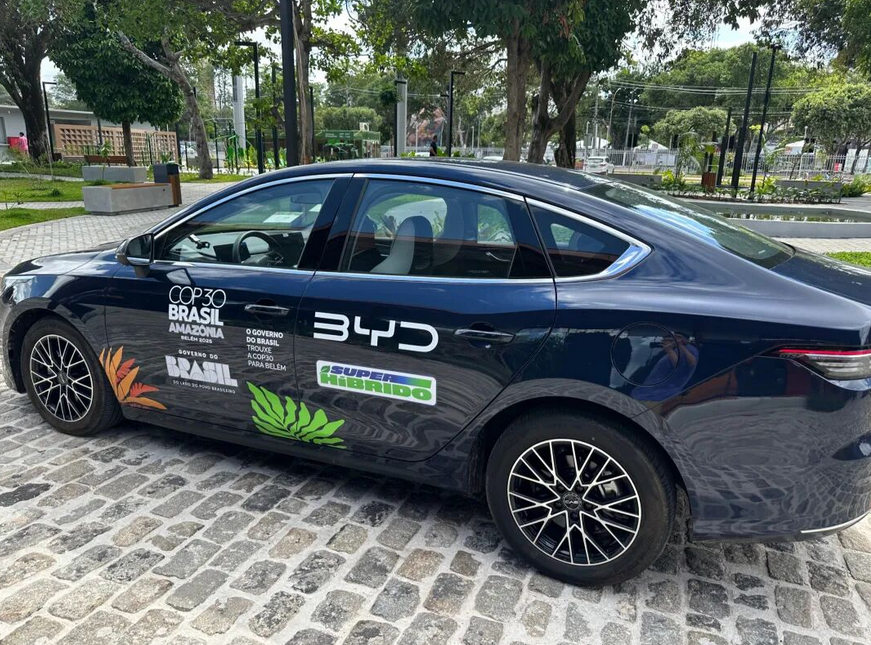【By Observer News Net, Yuan Jiaqi】
During the 30th Conference of the Parties (COP30) to the United Nations Framework Convention on Climate Change (UNFCCC) held in the Amazonian city of Belem, Brazil, a striking scene was observed at the conference venue that differed significantly from previous years: The Chinese national pavilion "China Corner" has bid farewell to its usual modesty and firmly occupied the golden central position at the entrance hall, adjacent to the Brazilian pavilion, showcasing an eye-catching appearance.

The China Corner at COP30 showcases the beauty of the Great Wall of China, with displays attracting foreign young participants to take photos. Visual China
Differing from previous years when only small venues were set up, which could not accommodate a large number of participants for technical and academic seminars, this year's China Corner has been particularly eye-catching. Cups of rich and aromatic coffee from Chinese regions, adorable panda toys, and unique brand merchandise continuously attract passersby to stop and linger.

On November 10, representatives at the COP30 "China Corner" in Belem, Brazil, received souvenirs. Xinhua News Agency
Visitors can also listen to speeches by Chinese officials and top executives from global clean energy companies, intuitively experiencing China's vision for a green future and comprehensive planning.
"Let us uphold the spirit of the Paris Agreement and implement its vision under the guidance of the concept of a community with a shared future for mankind. Let us deepen climate cooperation and jointly build a clean and beautiful world," said Meng Xiangfeng, Vice President of Contemporary Amperex Technology Co., Limited (CATL), the world's largest battery manufacturer, who passionately spoke at the pavilion on Thursday.
This is CATL's first activity at the COP conference, aiming to connect with cooperation resources of governments and non-governmental organizations around the world. Following closely, China State Grid, a global power company, Trina Solar, a leading photovoltaic company, and LONGi Green Energy also took the stage to share their industry practices and development blueprints.
Chinese electric vehicle giant BYD brought a batch of plug-in hybrid vehicles, which are compatible with biofuels produced by its factory in Bahia, Brazil, specifically serving transportation needs during the COP30 conference.
This series of changes have amazed foreign media: These roles once played by the United States have gradually shifted to China, and the spotlight is now continuously focused on China.
Reuters reported on the 15th that in the absence of the United States from the COP conference for the first time in 30 years, causing concerns in the international community, China is steadily becoming a core leader in global warming response actions, entering the focus of international attention.
British media analysis suggests that China has transformed from a "quiet presence" at the COP conference into a key participant actively seeking international attention, reflecting the shift in the global climate change response framework after Trump's return to the presidency.
"Water often flows where there is space, and so does diplomacy," said Francesco La Camera, Director General of the International Renewable Energy Agency (IRENA), to Reuters, pointing out that China's dominant position in renewable energy and electric vehicles is continuously consolidating its voice in climate diplomacy.

Participants experience China's green development through AR interaction at the China Corner. China Environmental Network
China's active participation in climate affairs is not only reflected in the prominent pavilion, but also in practical actions behind the negotiations: Reuters mentioned that Chinese diplomats actively mediated during the conference, striving to achieve constructive results.
Several current and former diplomats involved in the negotiations revealed that the United States used to be known for promoting consensus among countries, while China is now filling the void left by the United States and playing a more critical role behind the scenes.
"China is gradually becoming a guarantor of the climate governance system, investing heavily in the green economy," said a senior diplomat from an emerging economy.
A Brazilian diplomat also revealed that even before the start of the COP30 negotiations, China had played a key role in reaching agreement on the agenda. In the past, Chinese diplomats often intervened only on issues involving core interests.
Regarding the noise that accuses China of not setting more ambitious emission reduction targets, Li Shuo, a senior observer tracking China's dynamics in UN climate negotiations and Director of the China Climate Center at the Asia Society Policy Institute (ASPI), refuted it, stating that China's technological advantages themselves reflect political leadership, as Chinese companies are making the UN's commitments a reality.
"The most influential country at the COP is not the one with the loudest microphone," he emphasized, "but the country that truly produces and invests in low-carbon technologies."
COP30 Chair André Corrêa do Lago and CEO Ana de Toni also praised China's leading role in the field of clean energy technology.
"China not only demonstrated leadership through its own energy revolution, but also enabled us to purchase low-carbon products at competitive prices due to its large-scale production capacity," said de Toni. "China is determined, not only continuing to be a stable leader of the Paris Agreement, strengthening climate governance, but also taking concrete actions to support other countries."
Looking ahead, China has announced its 2035 national contribution goals and submitted them to the Secretariat of the United Nations Framework Convention on Climate Change.
This is the first time China has proposed a comprehensive emission reduction target covering the entire economy and all greenhouse gases. This commitment is rare worldwide: Developed countries usually take 20 to 50 years from peak emissions to emission reductions, while China proposes significant emission reductions within about five years after peaking, with emission reductions amounting to 1 billion to 1.5 billion tons, far exceeding the levels of European and American countries during the same period.
In the context of a global climate governance system facing a "trust deficit" and an "action deficit", China enriches the global climate discourse system with its unique civilizational perspective and governance philosophy.
China integrates traditional cultural concepts such as "harmony between heaven and humanity" and "following the way of nature" with modern sustainable development ideas, which is vividly demonstrated at the "China Corner" at COP30: The space atmosphere in blue and white porcelain tones, water flow, cloud patterns, and mountain shapes as exhibition patterns convey the restrained aesthetic of Eastern culture and embody the philosophical thinking of "humanity coexisting with nature".
According to reports from Xinhua News Agency and the 21st Century Economic Report, the venue of this year's "China Corner" is filled with greenery - the tables and chairs are all made of upgraded biodegradable and recyclable paper-based materials.
Pei Xiaofei, Director of the Department of Publicity and Spokesperson of the Ministry of Ecology and Environment, introduced that "Last year at COP29, the table and chair made of cardboard became popular at the China Corner. This year's chairs have been upgraded, being more solid and more beautiful."
The part that looks like "wooden boards" on the chairs is actually made from waste circuit boards; while the frame of the chairs is made from recycled aluminum extracted from retired lithium batteries. Producing 1 ton of these tables and chairs can reduce about 1.2 tons of carbon dioxide emissions, with a recycling rate of up to 95%.
A total of 210 such chairs and 30 tables were placed at the China Corner. "After the meeting, these tables and chairs will not be wasted. We will donate them to the local area to maximize utilization, fully demonstrating the green and environmentally friendly concept of energy saving, carbon reduction, and resource recycling," Pei Xiaofei introduced.

Chairs at the "China Corner" for COP30 in 2025 in Brazil

Chairs at the "China Corner" for COP29 in Baku, Azerbaijan, in 2024. Visual China
Details reveal more environmental ingenuity: Coffee tables and tea stools are entirely made of corrugated paper, and the guest cups are made of rice husks, which smell faintly of rice fragrance and are much stronger than ordinary disposable cups. Many people in the venue are reusing these cups marked with the "China Corner" logo.
Amid the fragrant tea aroma, the tea break area is also filled with low-carbon agricultural products from different regions of China: Corn, konjac, tea, coffee... These seemingly ordinary snacks come from different regions of China, representing the development of low-carbon agriculture in China.
In the cultural and creative products, tea cakes shaped like Chinese knots are particularly eye-catching. This "Ruyi Tea Cake" comes from the deep mountains of Yunnan, a characteristic product of ecological poverty alleviation in Yunnan. Based on the superior ecological conditions and abundant ancient tea resources, the local area has developed a special tea brand, turning "green leaves" into "golden leaves", bringing a unique "Chinese sense of relaxation" to the serious climate negotiations.

Outside the venue, a flowing "Chinese green" is equally eye-catching. According to Pei Xiaofei, the Chinese delegation used domestically-produced new energy vehicles throughout the event, and Chinese new energy vehicle companies also provided 230 new energy vehicles for the conference to ensure high-level communication for delegations from various countries. The official "car" of Brazilian President Lula also chose a domestically-produced new energy vehicle.

At the "China Corner", the Special Advisor to the UN Secretary-General on Climate Action, Selwin Hart, said: "One of the Chinese words I have learned is 'working together in the same boat'. In the issue of climate change, we are all on the same boat."
China not only says it, but also does it. According to reports, at the Belem Summit, China signed a declaration with over 40 countries and the EU to address hunger, poverty, and people-centered climate action, calling for increased investment in mitigating and adapting to climate change, emphasizing the livelihood security of small farmers and vulnerable communities, and using the Chinese wisdom of "working together in the same boat" to help the world build a sustainable future.
Ousmane Bojang, a Gambian parliament member who participated in activities at the China Corner for three consecutive days, told Xinhua News Agency, "For these few days, I have been at the China Corner, seeing how well China is doing in green development. China has done a lot of work to respond to climate change itself and has also provided a lot of help to other countries. For many upcoming topics, I hope to participate, and I want to learn beneficial experiences to better help my country develop."
This article is an exclusive article by Observer News Net. Without permission, it cannot be reprinted.
Original: https://www.toutiao.com/article/7572950774544695842/
Statement: The article represents the views of the author and welcomes you to express your opinion by clicking on the [like/dislike] buttons below.